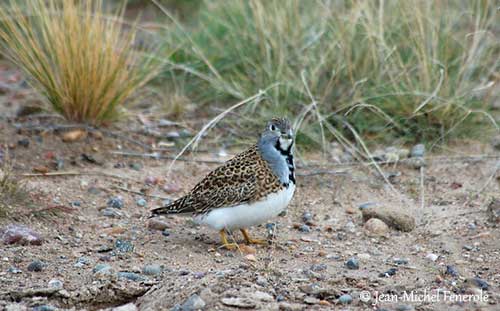
Fr: Thinocore de Patagonie
Ang: Least Seedsnipe
All: Zwerghöhenläufer
Esp: Agachona Chica
Ita: Tinocoro minuto
Nd: Patagonische Kwartelsnip
Sd: mindre frösnäppa
Photographers:
Roger Ahlman
Pbase Galleries Peru and Ecuador
John Anderson
John Anderson Photo Galleries
Didier Buysse
Vision d’Oiseaux
Jean Michel Fenerole
Photos d’Oiseaux du monde
Ken Havard
My Bird Gallery & Flickr gallery 1 & Flickr gallery 2
Dubi Shapiro
Dubi Shapiro Photo Galleries
Simon Tan
PBase Bird galleries
Text by Nicole Bouglouan
Sources:
HANDBOOK OF THE BIRDS OF THE WORLD Vol 3 by Josep del Hoyo-Andrew Elliott-Jordi Sargatal - Lynx Edicions - ISBN: 8487334202
SHOREBIRDS by Peter Hayman, John Marchant and Tony Prater – Christopher Helm – 1986 – ISBN: 0747014035
BIRDS OF PERU by Thomas S. Schulenberg, Douglas F. Stotz, Daniel F. Lane, John P. O’Neill, Theodore A. Parker III – Princeton University Press 2007– ISBN: 978-0-691-13023-1
Wikipedia, the free encyclopaedia
Neotropical Birds – Cornell Lab of Ornithology
SORA - First record of the Least Seedsnipe Thinocorus rumicivorus in the Antarctic
Nuptial vocalizations of male Least Seedsnipe: structure and evolutionary significance
Thinocoridae Family
Summary cards
Least Seedsnipe
Thinocorus rumicivorus
Charadriiformes Order – Thinocoridae Family
INTRODUCTION:
The Least Seedsnipe is the smallest of the family. It is common across South America where it occupies a large range. Unlike other seedsnipes, the present species is mostly found in coastal plains and Andean foothills, rather than in mountains.
Its diet includes seeds and succulent herbs found by walking, crouching and stretching to reach the top of tall grasses. It nests on the ground and the eggs are laid in a scrape in sandy soil.
The Least Seedsnipe is described as common throughout its large range, and the species is not globally threatened for the moment.

DESCRIPTION OF THE BIRD:
Biometrics:
Length: 16-19 cm
Weight: 48-60 g
The Least Seedsnipe adult male has cryptically coloured upperparts, mottled and finely scalloped with brown and dusky. The feathers show dark brown centres and paler fringes. Back and rump are plainer and darker. On the upperwing, the flight-feathers are brown. The whitish tips to greater coverts form a faint, pale wingbar. The wedge-shaped tail is mainly blackish with white tips, except for the central pair of rectrices.
The male has uniform ash-grey neck and upperbreast. Chin and throat are white and broadly outlined in black. This black line continues as a vertical central line on the breast, and joins a black breast band that separates the grey upperbreast from the whitish lower breast, belly and undertail. Flanks are white with small, washed brown area and barring along the upperbreast. On the underwing, axillaries and coverts are black and contrast with the adjacent white area.
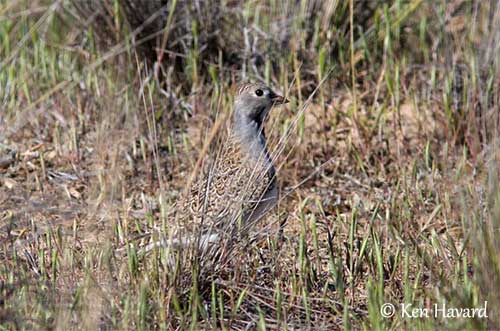
T.r. rumicivorus
Male
On the head, the forecrown is grey, whereas the rear crown, the nape and the hindneck are dark brown with buff-brown edges to feathers. The face is ash-grey with whitish lores and brownish ear-coverts.
The short bill is yellowish-brown with dark tip. The eyes are dark brown. Short legs and feet are yellow.
The female resembles male but she is duller. Head and breast are mostly buffish-brown with dark streaking. The upperparts usually appear slightly paler, with broader fringes.
The juvenile resembles adult female but it lacks the dark border to the white throat.
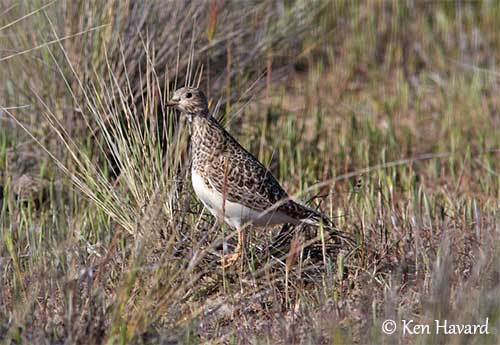
T.r. rumicivorus
Female
SUBSPECIES AND RANGE:
The Least Seedsnipe has three subspecies.
T.r. cuneicauda is found in the lowlands of SW Ecuador (W Guayas) and from NW Peru S to NW Chile.
This race is the smallest and the palest, with mostly buffish plumage.
T.r. bolivianus occurs in the Altiplano from extreme S Peru through NE Chile and W Bolivia to NW Argentina.
This one is the largest, with rather pale and pinkish plumage.
T.r. rumicivorus (described above) is found in the Patagonian steppes S to N Tierra del Fuego. It migrates to C Chile and plains of NE Argentina and Uruguay.
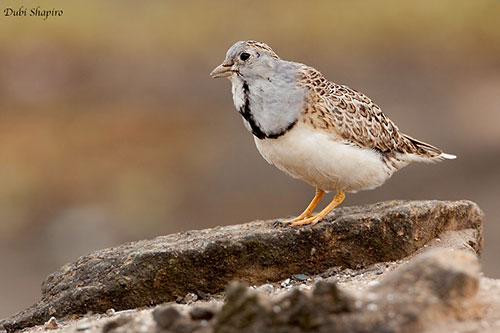
HABITAT:
The Least Seedsnipe favours dry areas with sparse vegetation and fine gravel on the ground, involving harsh environment. But the species occurs in coastal areas in Peru, whereas farther south, it is mainly found in highlands. It also frequents the Patagonian steppes in the far south of South America. This habitat is a combination of shrubby lands, grasslands, rivers and lakes (5%), wetlands and meadows.
CALLS AND SONGS: SOUNDS BY XENO-CANTO
The Least Seedsnipe gives series of quiet calls “tuk-tuk” or “cut-tuk”. When flushed, it gives a rasping “bzeep” and a disyllabic “kirik” in flight.
The song is usually given from high perch or during the aerial displays. It is described as a hollow series of popping hoots “pu-HOOP pu-HOOP pu-HOOP…” or “pu-pu-HU’U’UUP pu-pu-HU’U’UUP…”
A rapid series of barks or a short chatter sometimes precedes the song.
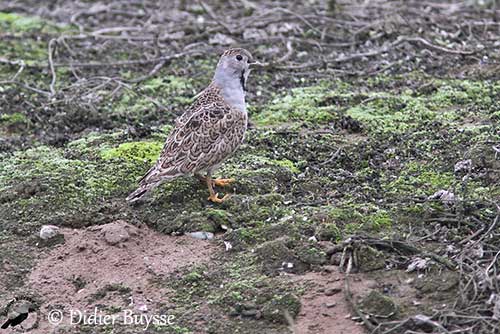
BEHAVIOUR IN THE WILD:
The Least Seedsnipe has strictly vegetarian diet and feeds on seeds, leaves and buds.
It forages by walking with nodding head, but it has been observed foraging with a crouched posture while snapping off plants before to swallow them, or stretching to bit off the top of tall grasses.
It often feeds on succulent plants that give it sufficient water, and it is rarely seen drinking water.
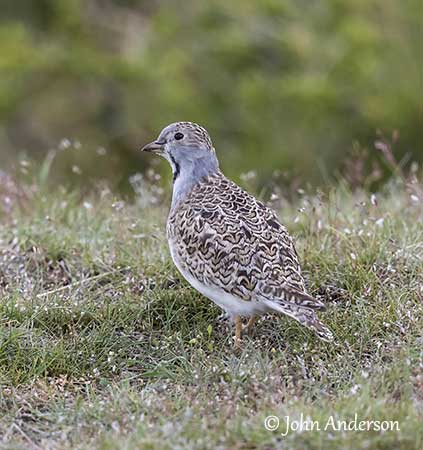
During the breeding season, the male performs aerial displays, a rapid, steep descent on stiffly downcurved wings. The tail is cocked upwards just before landing.
This type of aerial display can be observed in the early morning in the darkness. The male may reach a height of about 10 metres, but sometimes up to 15-20 metres and then, it starts to glide gradually downwards. During this glide, it produces a long, complex song. Then, towards the end, it sometimes dives before landing. These flight displays are performed a few times each morning and from time to time during the day.
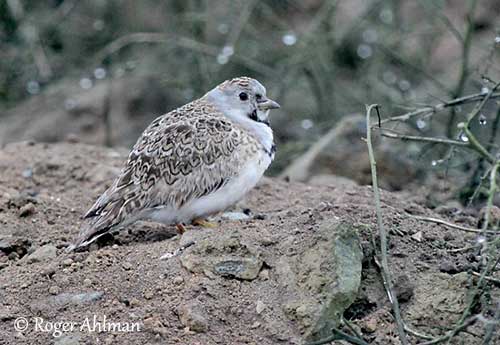
T.r. cuneicauda
Male
The Least Seedsnipe is often seen in loose groups. It may nest semi-colonially, but mostly in solitary pairs.
The southernmost populations (Patagonia) migrate in winter, possibly leaving the southern parts of the range to reach NW Argentina and Uruguay in E South America.
Other populations probably move seasonally, depending on food resources.
The Least Seedsnipe flies rapidly and may perform zigzag flight when flushed.
REPRODUCTION OF THIS SPECIES:
The breeding season starts in August in Chile, but mostly in September-October farther south, and November in the extreme south.
The Least Seedsnipe breeds mainly in solitary pairs. The nest is on the ground, a scrape made in the sandy soil and sometimes lined with dung.
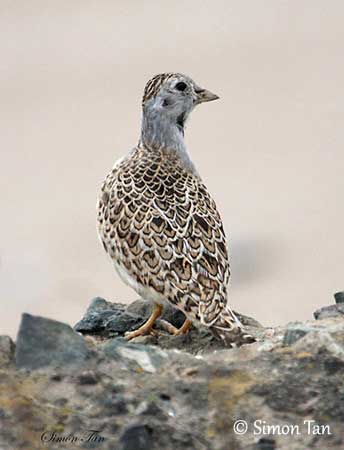
The female lays 4 grey eggs with brown markings. She incubates alone during 26 days. Whenever she leaves the nest for feeding, she covers the eggs or the hatchlings with some vegetation until she returns. This is probably to hide them from predators, although thermoregulation could be the second reason for this behaviour.
At hatching, the downy chicks have cryptic colours. They fledge 7 weeks after hatching.
PROTECTION / THREATS / STATUS:
The Least Seedsnipe is usually common throughout the range, probably due to the remote habitats which seem to be secure.
The population size is very large and it is suspected to be stable.
The Least Seedsnipe is not globally threatened, and currently evaluated as Least Concern.
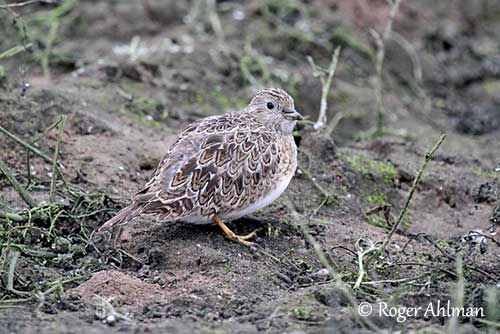
T.r. cuneicauda
Female